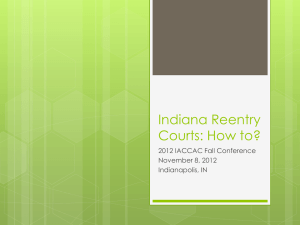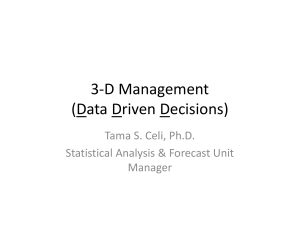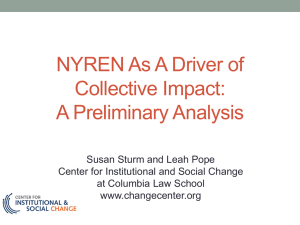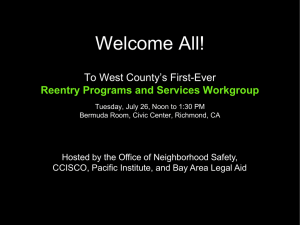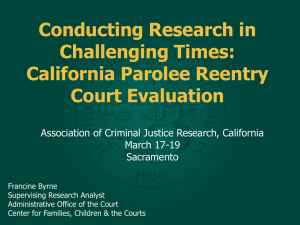Denise`s presentation to NACO March 2014
advertisement
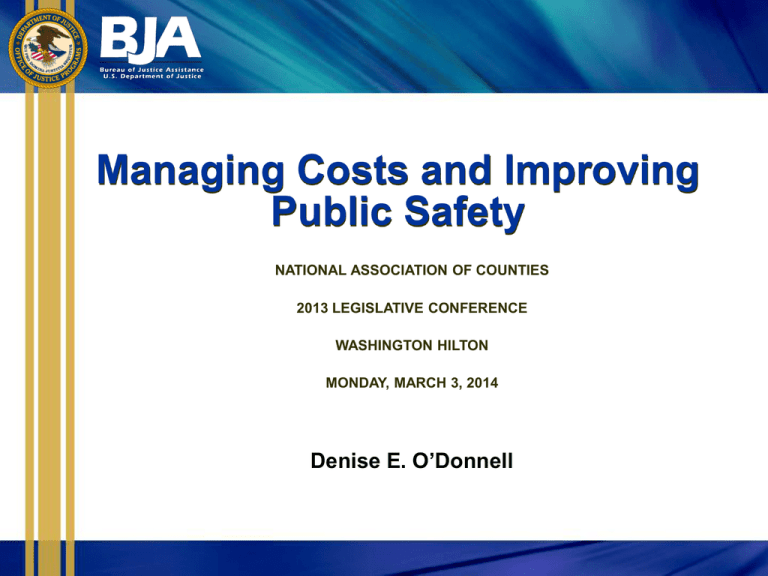
Managing Costs and Improving Public Safety NATIONAL ASSOCIATION OF COUNTIES 2013 LEGISLATIVE CONFERENCE WASHINGTON HILTON MONDAY, MARCH 3, 2014 Denise E. O’Donnell Counties Matter • Most crimes happen locally and most justice is administered at the local level through courts, prosecution, indigent defense, and probation. • Counties are where the bulk of services are administered through hospitals, mental health and substance abuse treatment centers, etc. • In 2012, the jail incarcerated population was 33 percent (744,500) of the total incarcerated population (2,228,400). • About 700,000 people are released from state and federal prisons every year, but about 9-10 million cycle annually through jails. • Approximately 2/3 of local detention is for those in a pretrial status, i.e. people who have not yet been found guilty of any crime. BJA Invests in Counties Through • • • • • • Criminal Justice Reform Pre-trial Reform Reentry Place-based Initiatives Improving Prosecution Improving Indigent Defense Justice Reinvestment Three-Step Process Bipartisan, Inter-Branch, Inter-Disciplinary Structure 1 Analyze Data and Develop Policy Options • Analyze data to look at crime, court, corrections and supervision trends • Solicit input from stakeholders • Map allocation of resources • Develop policy options & estimate cost savings 2 3 Adopt New Policies Measure Performance • Identify assistance needed to implement policies effectively • Deploy targeted reinvestment strategies to increase public safety • Review implementation progress • Track the impact of enacted policies/programs • Monitor recidivism rates and other key measures Justice Reinvestment State Assessment Report • Report describes the progress, challenges and preliminary outcomes of 17 JRI states from 2010 to summer 2013. • All eight of the sites that had JRI policies in effect for at least one year have experienced meaningful reductions in their prison populations, and five of them have met or exceeded their population reduction goals. • Report estimates that there will be a total projected savings of as much as $4.7 billion over a 10 year period. JRI Resources • • • • • • • BJA Website – JRI Page: https://www.bja.gov/ProgramDetails.aspx?Program_ID=92 Center for Effective Public Policy: http://cepp.com/justice-reinvestment Crime and Justice Institute: http://www.crj.org/cji/projects Urban Institute: www.urban.org/center/jpc/justice-reinvestment/resources.cfm • Justice Reinvestment: A Toolkit for Local Leaders • The Criminal Justice Planner’s Toolkit for Justice reinvestment at the Local Level Council of State Governments: http://csgjusticecenter.org/jr/ VERA Institute For Justice: http://www.vera.org/centers/center-sentencing-andcorrections Pew Center on the States: Public Safety Performance http://www.pewcenteronthestates.org/initiatives_detail.aspx?initiativeID=31336 Pre-Trial Reform • Reform at the front end of the criminal justice system is key to improved outcomes at each subsequent stage – problem-solving courts, smarter sentencing, smarter policing and prosecution, and smarter probation and parole • The use of validated risk assessment tools to inform pretrial release decisions is critical. • www.pretrial.org, maintains BJA-funded publications, including a number of case studies on successful jurisdictions, and many policy briefs on risk assessment, supervision, and other related topics. Reentry and Recidivism Reduction • • • • Seven programs provide resources to states, tribes, cities/counties and non profit agencies to affect change and reduce recidivism among different reentry populations through the Second Chance Act (SCA). Over $1 billion in SCA funds requested; to date over $300 million in grants have been made to 600 recipients in 49 states New focus on leveraging Affordable Care Act and recidivism reduction opportunities Since its initial administration in Fiscal Year (FY) 2009, SCA programs have included the following: Adult offenders with co-occurring substance abuse and mental health Adult and juvenile demonstration (planning and implementation) projects Reentry courts Adult and juvenile mentoring programs Technology careers training projects for incarcerated adults and juveniles Adult statewide recidivism reduction projects Smart probation projects Evaluation of adult and juvenile reentry demonstration projects . • National Reentry Resource Center (www.nationalreentryresourcecenter.org ) synthesizes what works in reentry and disseminates through website, webinars, national convenings, and peer networks. • National conferences and workshops • Four evaluation projects underway assessing process, cost, implementation and impact of many SCA-funded adult and juvenile projects Federal Coordination Through the Reentry Council National Reentry Resource Center inventoried and mapped major federal reentry resources going to states and localities Address Federal Barriers to Reentry Federal Coordination Barriers to Employment Public Housing Veterans 38,000 Collateral Consequences Access to Benefits Address Common Reentry Myths Each sheet addresses a common ‘myth’ about reentry, ranging from federal financial aid to employment issues. It lists facts debunking the myth, answering common misperceptions… …describes the details of each, including explanations of different state policies… …and lists important suggestions and recommendations for readers. At the end of the form, each sheet lists useful online resources. Criminal Justice/Mental Health • Women’s Pathways to Jail: The Roles and Intersections Serious Mental Illness and Trauma • https://www.bja.gov/Publications/Women_Pathways_to_Jail.pdf The findings of a study which found that a national sample of women in jails showed high rates of mental health problems • Adults with Behavioral Health Needs under Correctional Supervision: A Shared Framework for Reducing Recidivism and Promoting Recovery • The report is written for policymakers, administrators, and service providers committed to improving outcomes for the large number of adults with mental health and substance use disorders that cycle through the criminal justice system. • http://consensusproject.org/jc_publications/adults-withbehavioral-health-needs Byrne Criminal Justice Innovation • Created as part of the Obama Administration’s larger neighborhood revitalization efforts to help local and tribal communities develop place-based, community-oriented strategies to change neighborhoods of distress into neighborhoods of opportunity. BCJI was launched in 2012. • Through coordinated federal support, this interagency effort aligns programs of the Departments of Education (Promise), Justice (BCJI), Housing and Urban Development (Choice), Health and Human Services and Treasury Map of FY12 and FY 13 BCJI Grantees Seattle, Washington Milwaukee Wisconsin Omaha Nebraska Omaha, Kansas City, Missouri Buffalo, New York Detroit, Michigan Evansville, Indiana Syracuse, New York Dayton, Ohio Lowell, Massachusetts Dayton Ohio Cleveland, Ohio Portland, Oregon Springfield, Massachusetts Providence, Rhode Island Corning, California Brooklyn, New York San Francisco, California Philadelphia, Pennsylvania Los Angeles, California Erie, Pennsylvania Charleston, West Virginia Charleston West Virginia San Bernardino, California FY 2012 Grantees (15) FY 2013 Grantees (14) Cross-sector teams are using evidencebased, community-driven strategies to address crime hot spots in specific neighborhoods in each city Albany, Georgia San Antonio, Texas Austin, Texas Baton Rouge,Austin Louisiana Texas Nashville, Tennessee Tampa, Florida Baltimore, Maryland BCJI Core Program Elements • Place Based: Targets crime “hot spots” or microplaces as part of a comprehensive neighborhood development strategy • Data-driven problem solving: Uses local researcherpractitioner partnership to use data to clearly define problems and identify solutions • Community-oriented: Seeks to catalyze and sustain change through active involvement and leadership of neighborhood residents, as part of a broad cross sector partnership team. • Cost effective: Place-based strategies should maximize local resources; BCJI promotes leveraging all other funding sources (federal, state, local, and private.) BCJI Site Funding • FY 12 and FY 13 Solicitations: • • • • Planning and Implementation (up to $1 million) Planning and Enhancement (up to $600,000) 29 total grantees (17 P & I, 12 ENH) FY14 solicitation planned • Training and Technical Assistance: Provided by the Local Initiatives Support Corporation (LISC). BJA Tools for the Field • Risk–Needs–Responsivity Simulation Tool • BJA and its academic partners have developed a Risk, Needs, & Responsivity (RNR) simulation tool to address recidivism issues in jurisdictions. • This tool will enable jurisdictions to reform their incarceration and reentry processes so that they can learn to identify an individual’s risk level and several criminogenic needs, and then develop appropriate programming for that individual. • http://www.gmuace.org/research_rnr.html BJA Tools for the Field • Cost Benefit Knowledge Bank for Criminal Justice (CBKB) • Provides resources for justice practitioners and policymakers interested in using cost-benefit analysis methods and applications to better evaluate the economic impact of criminal justice policy choices. • cbkb.org BJA’s National Training and Technical Assistance Center (BJA NTTAC) • BJA NTTAC facilitates the delivery of high-quality, strategically focused training and technical assistance (TTA) to state, local and tribal jurisdictions. • BJA NTTAC works to improve the criminal justice system by providing rapid, expert, coordinated, and data-driven TTA to support practitioners in the effort to reduce crime, recidivism, and unnecessary confinement in state, local, and tribal communities. National Training and Technical Assistance Center (BJA NTTAC) • The TTA services provided through NTTAC cover a broad set of topic areas including training, information dissemination, technical assistance, and facilitation of multi-agency and cross-jurisdictional teams and working groups. • TTA Examples: Implementing evidence-based programs, curriculum development, data analysis, onsite and distance learning training, peer-to-peer visits, research and information requests, and strategic planning assistance. • For more information and to request TTA: www.bjatraining.org NTTAC’s Crime Analysis on Demand • TTA to law enforcement agencies to enhance their capabilities to analyze and use data to make informed decisions, respond effectively, and prevent crime. • Crime Analysis on Demand process is as follows: • • • • Conduct a needs assessment to determine analytical gaps and needs. Develop and present recommendations for addressing the identified gaps and needs. Document how the recommended TTA would promote organizational change, help reduce crime and enhance public safety, and data sources and elements that will be used to support these conclusions. Outline technical solutions that enable real-time sharing of crime data and analytical products on a local, regional, and statewide basis including examples of best practices in collaboration that address crime needs that involve distance learning tools and Bureau of Justice Assistance Office of Justice Programs U.S. Department of Justice Contact: Denise E. O’Donnell Director 810 7th St., NW Washington, DC 20531 Tel: 202-616-3613 denise.odonnell@usdoj.gov



